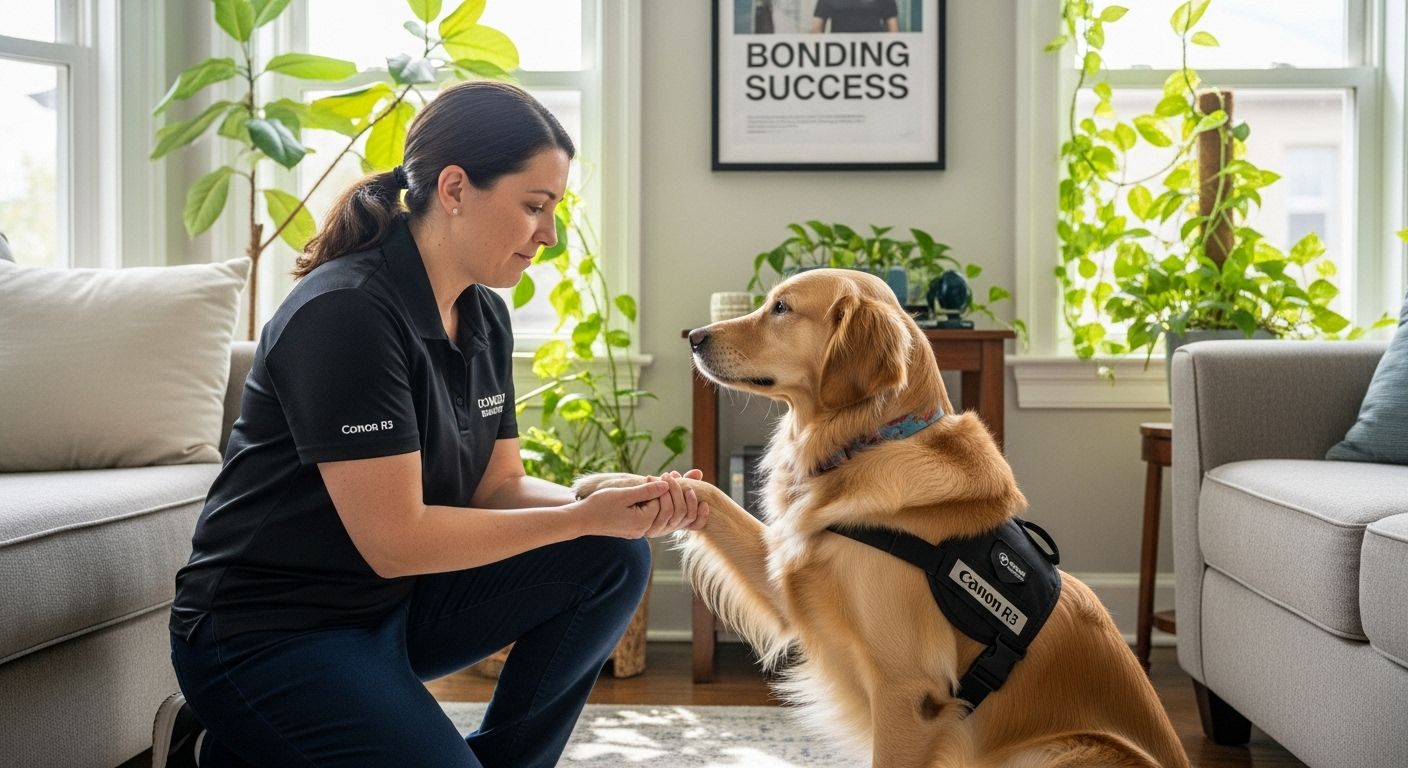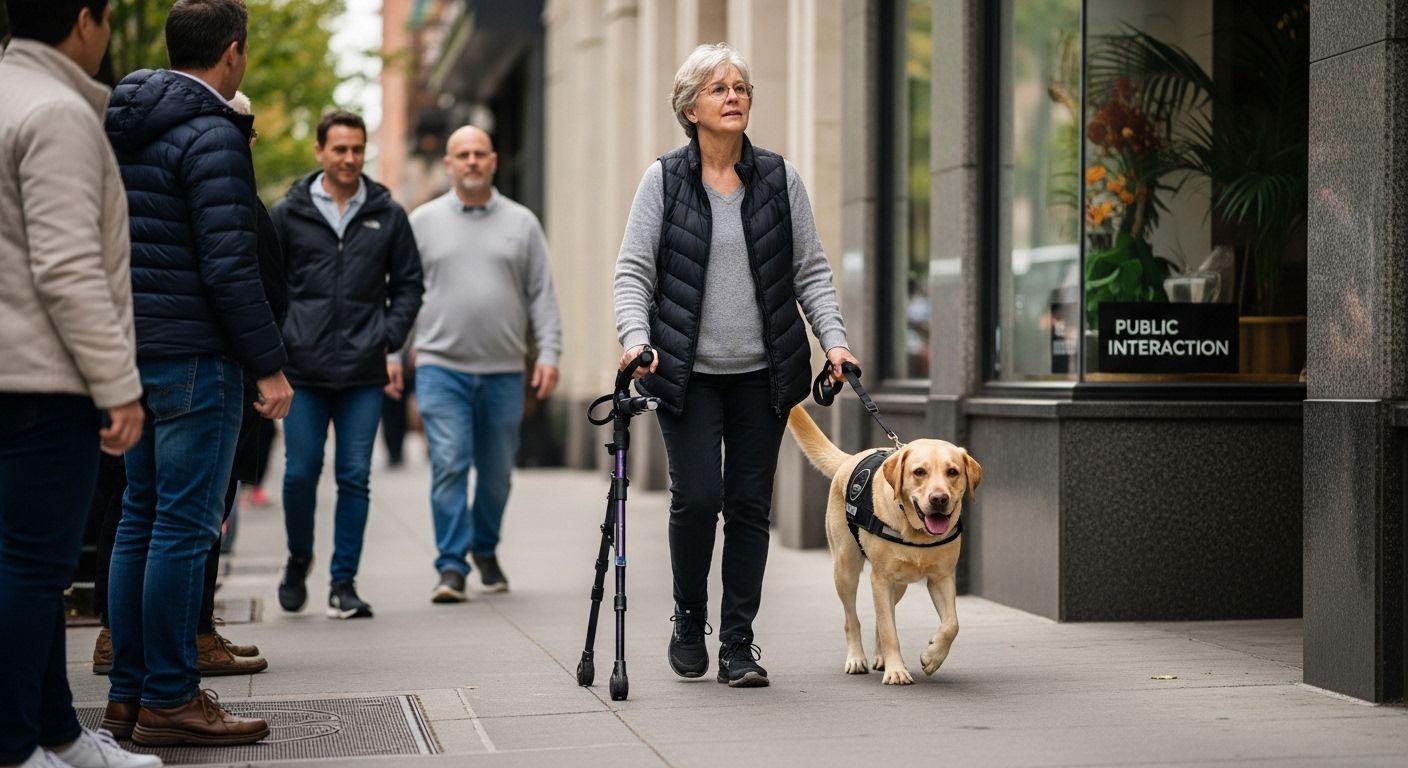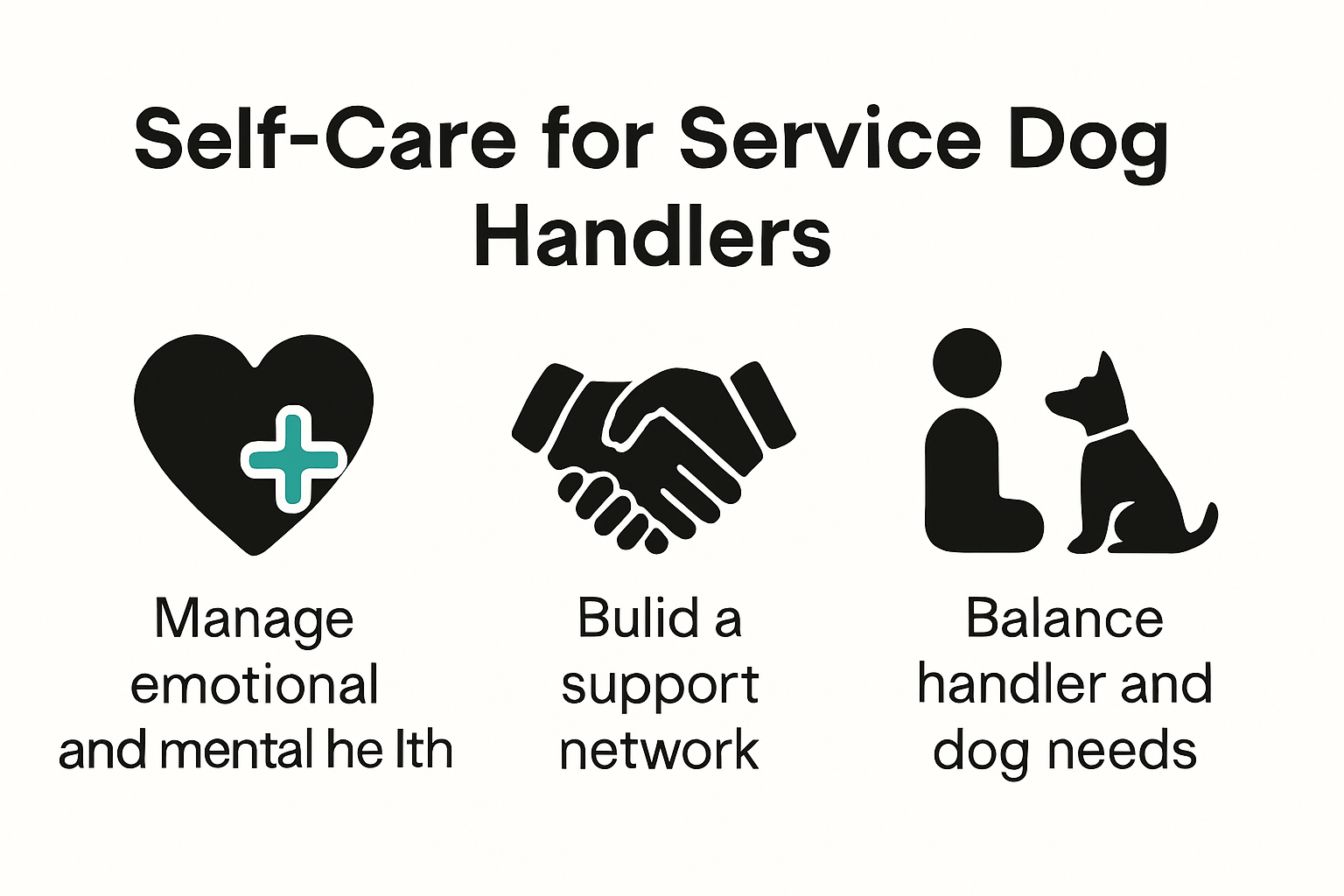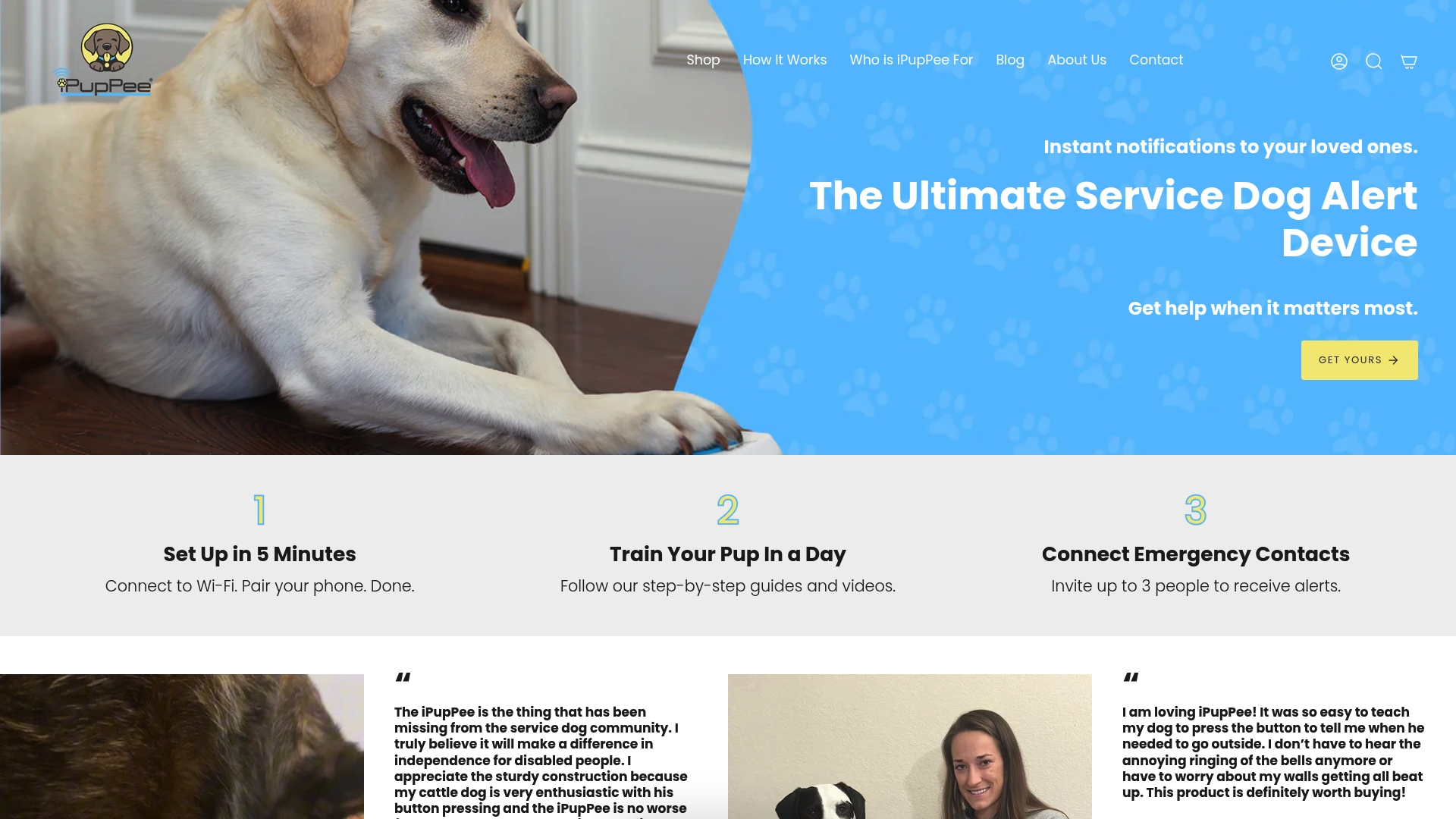
Working with a service dog changes lives in ways most people never imagine. You might picture a perfectly trained canine at your side, always ready to help, but reality has a few surprises. Studies show that strong trust between handler and dog can boost performance and dramatically improve day-to-day independence. So while training techniques matter, the real magic lies in how you connect and grow together far beyond the basics.
Table of Contents
- Building Trust Between Handler And Dog
- Training Techniques For Everyday Challenges
- Essential Safety And Public Etiquette Tips
- Self-Care And Support For Handlers
Quick Summary
| Takeaway | Explanation |
|---|---|
| Build trust through positive reinforcement | Use reward-based training to strengthen the bond with your service dog. Consistent positive interactions boost trust and motivation. |
| Practice structured progressive training | Start with basic commands in controlled settings and gradually introduce distractions to prepare the dog for real-world challenges. |
| Set clear public interaction boundaries | Politely communicate that strangers should not distract your service dog, ensuring it remains focused on its duties. |
| Prioritize self-care for handlers | Maintain personal health and boundaries to sustain an effective partnership with your service dog and prevent burnout. |
| Establish a support network | Connect with other handlers and resources for emotional support and practical advice to navigate challenges together. |
Building Trust Between Handler and Dog
Building a strong and reliable bond between a service dog and its handler is fundamental to creating an effective partnership that supports the handler’s daily life and specific needs. Trust is not something that happens instantly but develops through consistent, intentional interactions and mutual understanding.
Understanding the Foundation of Trust
Trust in a service dog partnership goes far beyond basic obedience. Research from the National Institutes of Health reveals that mutual trust significantly enhances the working relationship, impacting both the dog’s performance and the handler’s quality of life. This trust develops through a combination of communication, respect, and positive reinforcement.
Handlers must recognize that their service dog is not just a tool but a living partner who requires emotional connection and consistent care. Every interaction becomes an opportunity to strengthen the bond. This means being attentive to the dog’s body language, understanding their stress signals, and responding with patience and compassion.
Practical Strategies for Building Trust
Developing trust involves deliberate and mindful practices. Consistent Positive Reinforcement plays a crucial role. Dogs respond exceptionally well to reward-based training that celebrates their successes rather than punishing mistakes. This approach helps the dog feel secure and motivated to work closely with their handler.
Nonverbal communication is equally important. Handlers should maintain calm energy, use gentle touch, and provide clear, predictable signals. Your dog needs to feel safe and understand that you are a reliable source of guidance and protection. Learn more about building unbreakable connections with your service dog.
Time spent together outside of work tasks is also critical. Engaging in play, going for walks, and sharing quiet moments help deepen the emotional connection. These experiences teach the dog that the relationship extends beyond structured work, creating a genuine partnership based on trust and mutual respect.
Recognizing and Respecting Individual Needs
Every service dog handler and dog partnership is unique. Some dogs might require more reassurance, while others are naturally more confident. Handlers must be attuned to their individual dog’s personality, learning style, and emotional landscape.
Patience is key. Trust is not built overnight but through hundreds of small, consistent interactions. Celebrate small victories, be understanding during challenging moments, and always approach training and daily life with empathy and respect for your canine partner.
By prioritizing trust, communication, and mutual understanding, service dog handlers can create a powerful, symbiotic relationship that supports independence, safety, and emotional well-being for both handler and dog.
Training Techniques for Everyday Challenges
Service dog training extends far beyond basic obedience. It requires nuanced approaches that prepare the dog to navigate complex real-world scenarios while providing consistent support for their handler’s specific needs. Understanding and implementing effective training techniques can transform everyday challenges into manageable interactions.
Structured Progressive Training
According to the U.S. Department of Justice guidelines, service dog training must emphasize consistency and adaptability. Handlers should develop a structured training approach that progressively introduces complexity. This means starting with fundamental skills in controlled environments and gradually expanding to more unpredictable settings.
Begin with core obedience commands like sit, stay, and heel. Then systematically introduce distractions and varied environments. Practice in quiet rooms, then move to busier spaces like hallways, parks, and eventually crowded public areas. Each progressive step challenges the dog to maintain focus and perform tasks despite potential interruptions.
To help handlers practice structured training and ensure their service dogs are ready for real-world scenarios, the following table summarizes the steps of structured progressive training along with key actions for each stage.
| Training Stage | Environment | Key Actions |
|---|---|---|
| Basic Obedience | Controlled/Quiet | Teach sit, stay, heel with minimal distractions |
| Distraction Introduction | Slightly Busy | Introduce mild distractions, reinforce focus |
| New Environments | Public Spaces | Practice skills in parks, hallways, new settings |
| High Distraction | Crowded/Public | Maintain commands with significant interruptions |
| Real-World Scenarios | Unpredictable | Simulate daily life challenges and adapt as needed |
Task-Specific Skill Development
Targeted Training becomes crucial for service dogs. Unlike standard pet training, service dog preparation requires teaching specific assistance tasks tailored to the handler’s unique requirements. Research published in Frontiers in Veterinary Science emphasizes the importance of positive reinforcement and structured routines in developing these specialized skills.
Identify precise tasks your service dog needs to perform. These might include retrieving items, providing stability support, interrupting anxiety responses, or alerting to medical conditions. Break down complex tasks into smaller, manageable steps. Use reward-based techniques that make learning engaging and build the dog’s confidence. Discover advanced training strategies for specialized service dog skills.
Managing Unexpected Scenarios
Real-world service dog work involves unpredictability. Training must prepare dogs to remain calm and responsive in challenging situations. This requires exposing them to diverse scenarios simulating potential stress triggers. Practice maintaining commands during loud noises, sudden movements, or crowded environments.
Emotional regulation is as important as physical skill. Teaching a service dog to recognize and respond to their handler’s emotional state requires patience and consistent practice. Use controlled exposure techniques that gradually build the dog’s confidence and resilience.
Successful service dog training is a continuous journey of learning and adaptation. By implementing structured, compassionate training techniques, handlers can develop a reliable, responsive partner capable of providing exceptional support across various life challenges.
Essential Safety and Public Etiquette Tips
Navigating public spaces with a service dog requires understanding complex social dynamics and maintaining professional boundaries. Safety and proper etiquette are not just courteous practices but critical components of ensuring the service dog can perform its essential duties effectively.
Handler and Dog Protection Strategies
Canine Community Heroes emphasizes the critical importance of preventing unnecessary interactions with service dogs. Public spaces can present numerous distractions and potential risks that could compromise the dog’s concentration and ability to support its handler.
Proactive Communication becomes a key strategy. Handlers should be prepared to politely but firmly communicate boundaries. This might involve using clear verbal statements or wearing vest patches that discourage unwanted interactions. The goal is creating a protective bubble that allows the service dog to remain focused on its primary responsibilities.
Explore comprehensive safety training techniques for service dogs to enhance your understanding of protection protocols.
Public Interaction Guidelines
According to Loyola University Maryland, proper public etiquette involves direct communication with the handler, not the dog. Strangers should never attempt to pet, feed, or distract a working service dog. These interactions can disrupt the dog’s critical tasks and potentially endanger the handler.
Handlers should be prepared with concise, educational responses when encountering curious individuals. Brief explanations about the dog’s working status and the importance of maintaining focus can help educate the public while preserving the dog’s professional environment.
Navigating Complex Public Scenarios
KSDS Assistance Dogs, Inc. highlights that service dogs are carefully selected for their exceptional temperament and ability to remain calm in challenging environments. However, handlers must still actively manage potential stressful situations.
Strategies for managing public interactions include:
- Positioning the dog to minimize unexpected contact
- Practicing calm redirection techniques
- Developing confident body language that signals professional boundaries
- Carrying informational cards explaining service dog rights and roles
Understanding legal protections is equally important. The Americans with Disabilities Act provides specific guidelines protecting service dog handlers’ rights in public spaces. Handlers should be familiar with these regulations to confidently address any potential discrimination or inappropriate interactions.
By maintaining clear boundaries, educating the public, and prioritizing the service dog’s working status, handlers can create safe, respectful environments that allow their canine partners to provide exceptional support.

Self-Care and Support for Handlers
Service dog handlers face unique challenges that extend beyond managing their daily tasks with a service animal. The emotional and physical demands of this partnership require dedicated self-care strategies and robust support systems to maintain both the handler’s and the dog’s well-being.
Emotional and Mental Health Management
Research published in medical journals highlights the critical importance of psychological support for service dog handlers. Managing a service dog is not just a practical arrangement but an emotionally intense relationship that can potentially lead to burnout if not carefully navigated.
Emotional Resilience becomes a key factor in successful service dog partnerships. Handlers must develop strategies to manage stress, process complex emotions, and maintain their mental health. This might involve seeking professional counseling, joining support groups, or developing personal coping mechanisms that acknowledge the unique challenges of their role.
Discover comprehensive strategies for service dog handler wellness to support your mental and emotional journey.
Physical Health and Personal Boundaries
According to the ADA National Network, self-advocacy and personal care are fundamental for handlers. This means establishing clear boundaries between professional care responsibilities and personal time. Handlers must recognize that taking care of themselves is not a luxury but a necessity for maintaining an effective service dog partnership.
Physical health strategies include:
- Regular medical check-ups
- Maintaining personal fitness
- Ensuring adequate rest and recovery
- Managing stress through exercise and relaxation techniques
It’s crucial to create a balanced lifestyle that allows for both professional functioning with the service dog and personal rejuvenation.
Building Support Networks
No handler should feel isolated in their journey. Creating a comprehensive support network involves connecting with other service dog handlers, disability support groups, and professional resources. These connections provide emotional understanding, practical advice, and a sense of community.
Support can come from various sources:
- Online support groups
- Local disability resource centers
- Professional counseling services specializing in disability support
- Family and friends who understand the unique challenges
Handlers should also educate their immediate support circle about the complexities of service dog partnerships. This helps create a more understanding and supportive environment that recognizes the handler’s unique needs and experiences.
Service dog handlers face multiple aspects of self-care to maintain an effective partnership. The table below summarizes key self-care strategies, practical tips, and available support resources mentioned in the article.
| Self-Care Aspect | Tips & Strategies | Support Resources |
|---|---|---|
| Emotional Health | Develop coping mechanisms, seek counseling, join groups | Professional counselors, support groups |
| Physical Health | Schedule regular check-ups, prioritize fitness & rest | Medical professionals, fitness programs |
| Setting Boundaries | Separate personal and work time, communicate needs | Disability advocates, ADA guidance |
| Community Support | Build a network, educate family/friends | Online communities, local centers |
By prioritizing self-care, maintaining robust support systems, and approaching their role with compassion and patience, service dog handlers can create a sustainable, fulfilling partnership that enhances both their and their dog’s quality of life.

Frequently Asked Questions
How can I build trust with my service dog?
Building trust with your service dog involves consistent positive reinforcement, engaging in activities outside of training, and being attentive to your dog’s individual needs and body language.
What training techniques should I use for everyday challenges with my service dog?
Structured progressive training is essential. Start with basic commands in quiet environments and gradually introduce distractions and new settings to prepare your dog for real-world challenges.
What public etiquette should I follow when with my service dog?
When in public, avoid allowing strangers to interact with your service dog. Politely communicate boundaries and use visual cues, like a vest that indicates the dog is working, to help maintain focus and minimize distractions.
Why is self-care important for service dog handlers?
Self-care is crucial for service dog handlers to manage the emotional and physical demands of the partnership. Regular check-ups, personal boundaries, and building a support network can help maintain both your well-being and the effectiveness of the partnership.
Strengthen Your Service Dog Partnership With Smart Solutions
Do you want deeper trust, safer independence, and clearer daily communication with your service dog? As explained in our guide, successful handler-dog relationships rely on strong bonds, effective communication, and proactive safety measures. Yet, even with all your dedication, it can be hard to overcome moments of confusion and outside distractions in real life.

At ipuppee.com, we bring next-level communication to your routine with innovative devices designed just for service dog teams. The iPupPee alert button gives your dog a simple way to let you know exactly what they need. Our tool supports your journey in building positive reinforcement, setting clear boundaries, and enhancing safety in public, just like you learned in this article. Learn how other handlers are boosting confidence and independence in our customer testimonials or explore all product details and training resources. Take control of your partnership today and see what better communication can do for you and your loyal companion.
Recommended
-
[
Understanding Service Dog Behavior: 2025 Guide for Owners & Handlers
– iPupPee](https://ipuppee.com/blogs/news/service-dog-behavior-guide-2025)
-
[
Training Service Dogs 101: Essential Steps for Success in 2025
– iPupPee](https://ipuppee.com/blogs/news/training-service-dogs-101-essential-guide-2025)
-
[
Training Service Dog Skills: How to Teach Essential Tasks
– iPupPee](https://ipuppee.com/blogs/news/training-service-dog-skills)
-
[
Dog Training and Bonding: Build Unbreakable Connections in 2025
– iPupPee](https://ipuppee.com/blogs/news/dog-training-and-bonding-build-connections-2025)
-
Pet Care When on Vacation: Best Tips for 2025 - Pet Care with Love

